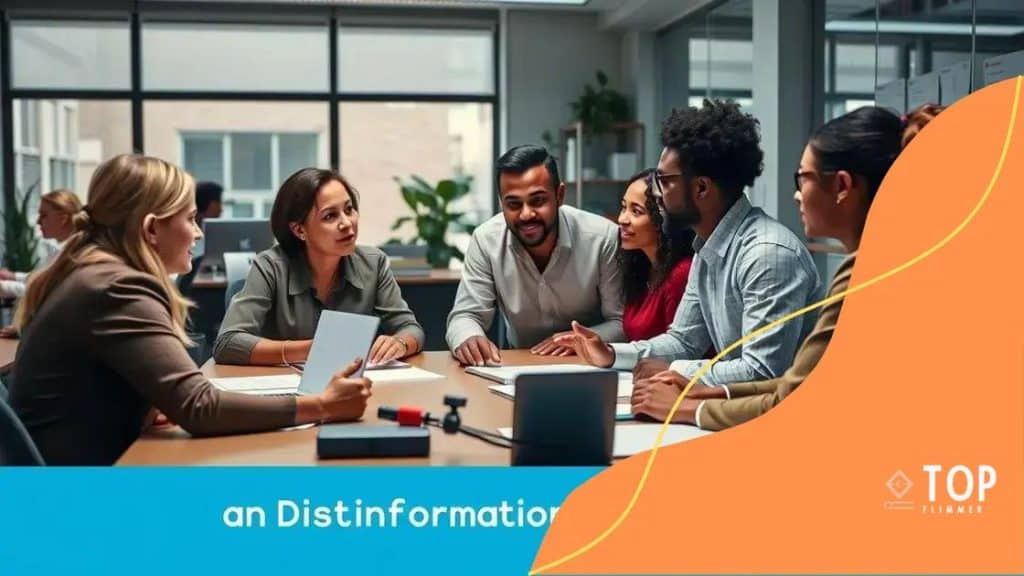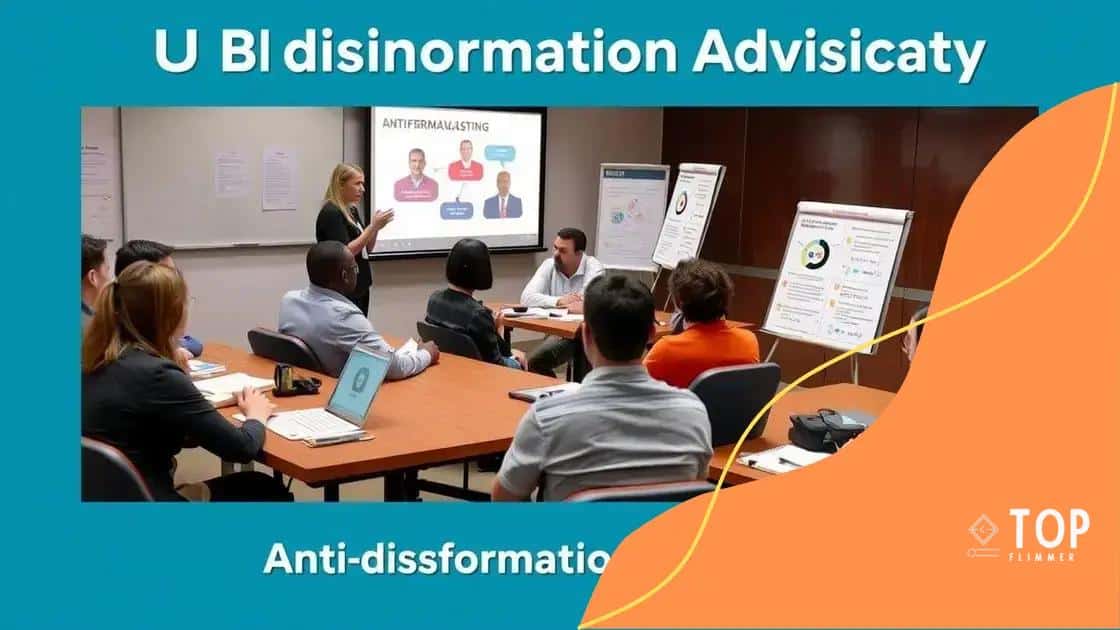Anti-disinformation advocacy campaigns: fighting the spread

Anti-disinformation advocacy campaigns are initiatives designed to educate the public, promote critical thinking, and utilize technology to combat misinformation effectively.
Anti-disinformation advocacy campaigns are vital tools in our battle against harmful misinformation. Ever wondered how these campaigns shape public awareness and influence behaviors? Let’s explore their impact and significance.
Understanding anti-disinformation advocacy
Understanding anti-disinformation advocacy is essential in today’s information age. These campaigns strive to educate the public on the dangers of misinformation and promote critical thinking skills.
The importance of anti-disinformation campaigns
Such initiatives can play a significant role in shaping informed citizens. With the rise of false narratives, advocacy efforts aim to counteract misleading information by providing clarity and context.
Key components of anti-disinformation advocacy
Effective campaigns often incorporate various strategies:
- Education on fact-checking and reliable sources.
- Community engagement to foster discussions about misinformation.
- Collaboration with technology platforms to flag false content.
Additionally, these campaigns focus on empowering individuals to recognize misleading information independently. Creating awareness around the tactics used by misinformation spreaders can prepare citizens to challenge these narratives. Social media also plays a pivotal role; by harnessing its power, advocacy groups can reach a wider audience and spread their message more effectively.
Another crucial aspect is the use of relatable narratives. By employing storytelling techniques, campaigns can connect with the target audience on a personal level. This helps in raising awareness about the consequences of misinformation and encourages action.
Measuring the impact of advocacy programs
To understand the success of these initiatives, it’s vital to measure their impact. Surveys and feedback mechanisms can provide insights into changes in public awareness and attitudes toward misinformation.
By focusing on clear objectives and adapting strategies based on feedback, anti-disinformation advocacy campaigns can continue to evolve, ensuring they remain effective in combating ever-changing misinformation tactics.
Key strategies for effective campaigns
Key strategies for effective campaigns play an important role in the fight against misinformation. To ensure that anti-disinformation advocacy campaigns succeed, several fundamental strategies need to be followed.
Building a strong message
A clear and impactful message is crucial. Campaigns should focus on simple language that resonates with the audience. Using relatable examples can help clarify complex topics. The message should encourage folks to think critically and feel empowered.
Engaging the community
Community involvement can amplify campaign efforts. This might include hosting workshops or partnering with local organizations. Creating opportunities for discussion lets people share experiences and learn from one another. Additionally, utilizing social media platforms helps spread awareness quickly.
- Encourage community feedback and involvement.
- Utilize social media for broader reach.
- Host workshops to educate local groups.
Furthermore, collaboration with other advocacy groups can enhance credibility and outreach. Sharing resources and knowledge allows campaigns to maximize their impact.
Regular evaluations of campaign effectiveness are also necessary. Gathering data, such as audience feedback and engagement metrics, can guide future strategies. This ongoing assessment helps identify what works and what needs improvement.
Utilizing technology
Technology can support key strategies effectively. For instance, creating apps or websites can help the public access reliable information quickly. These tools can assist in fact-checking and provide resources to help combat misinformation.
It is essential to keep up with the latest technological advancements. By staying informed, campaigns can adapt their approaches to reach younger and more tech-savvy audiences effectively.
Case studies of successful initiatives

Case studies of successful initiatives provide valuable insights into how anti-disinformation advocacy campaigns can make a difference. Learning from real-life examples helps refine future strategies and highlights best practices.
Example 1: The Truth Initiative
This organization has effectively tackled misinformation related to tobacco products. They use a mix of digital media campaigns and community outreach to educate the public about smoking myths. Their approach includes:
- Targeted social media ads that debunk common misconceptions.
- Workshops aimed at youth to enhance critical thinking.
- Collaboration with schools to spread awareness.
Through these efforts, they have successfully reduced tobacco use among teenagers.
Example 2: The International Fact-Checking Network (IFCN)
The IFCN brings together various fact-checking organizations to fight misinformation around the globe. Their initiatives focus on:
- Providing resources for fact-checkers.
- Promoting transparency in the fact-checking process.
- Encouraging collaboration between organizations.
By aggregating information and sharing tools, they have strengthened the global fight against misinformation.
Additionally, campaigns like “#Fakenews Challenge” engage the public to share and discuss misinformation stories. This initiative empowers individuals to become fact-checkers in their communities. Sharing personal experiences makes the message more relatable, encouraging active participation.
Successful campaigns also focus on adapting to the changing media landscape. For instance, integrating multimedia content such as videos, podcasts, and infographics can reach broader audiences. These formats capture attention and convey messages effectively.
Role of technology in combating misinformation
Role of technology in combating misinformation is an essential aspect of modern advocacy campaigns. Technology provides tools and platforms that can effectively counteract false information.
Utilizing social media for awareness
Social media platforms are key battlegrounds for misinformation. Campaigns can harness these platforms to share accurate information widely. Strategies include:
- Creating shareable content that highlights facts.
- Engaging influencers to reach broader audiences.
- Utilizing hashtags to gather community support.
By engaging users directly, advocates can promote critical thinking and awareness regarding misinformation.
Developing fact-checking tools
Another crucial technological role includes the creation of fact-checking tools and apps. These tools help users verify the accuracy of information quickly. Features can include:
- Real-time fact-checking options for news articles.
- A database of reliable sources for verification.
- Interactive elements that guide users through fact-checking processes.
When individuals have easy access to reliable data, they are less likely to fall for misleading narratives.
Artificial intelligence also plays a significant role in identifying and flagging misinformation. Algorithms can analyze vast amounts of data to detect patterns and trends, which helps in the early identification of false claims. This technology supports rapid responses to emerging misinformation.
Moreover, media literacy programs powered by technology can educate users about how to discern credible information from falsehoods. Online courses and webinars can teach essential skills necessary for navigating today’s complex information landscape.
Future trends in advocacy and awareness
Future trends in advocacy and awareness reflect the evolving landscape of information and technology. As the fight against misinformation continues, several key trends are emerging that shape how advocacy campaigns operate.
Increased reliance on technology
Technology will play an even larger role in advocacy efforts. The use of advanced analytics and artificial intelligence can help organizations target their messages more effectively. By analyzing data patterns, campaigns can better understand their audience’s needs and preferences.
Emphasis on media literacy
Another important trend is the push for strengthened media literacy. As misinformation spreads, teaching individuals how to critically evaluate sources becomes paramount. Future programs will likely incorporate:
- Interactive workshops in schools and communities.
- Online courses aimed at various age groups.
- Collaborations with social media platforms to promote learning.
By enhancing media literacy, campaigns empower individuals to become discerning consumers of information.
Collaboration between sectors
The future will likely see more collaboration between various sectors—government, non-profits, and tech companies. These partnerships can lead to comprehensive strategies for combating misinformation and promoting public awareness. By joining forces, these sectors can pool resources and expertise to create more effective campaigns.
Grassroots movements will also gain momentum. Local communities will continue to play a vital role in advocacy, using their unique insights. This localized approach encourages tailored solutions to misinformation in specific contexts.
Personalization of advocacy messages
Personalization will become a significant aspect of campaigns. Tailoring messages to fit individual beliefs and preferences can increase engagement. For instance, using data-driven insights to offer customized content can make a campaign more relatable.
As social media platforms evolve, the ways in which advocacy groups share their messages will change too. Emerging trends such as video content, podcasts, and interactive visuals will capture attention better and create more impactful narratives.
In summary, understanding and addressing misinformation is crucial in today’s digital world. Anti-disinformation advocacy campaigns are evolving with technology, media literacy, and collaborative efforts. By focusing on future trends like personalized messaging and community engagement, we can create a more informed society. Continued education and awareness are key to combating misinformation effectively.
FAQ – Frequently Asked Questions about Anti-Disinformation Advocacy Campaigns
What are anti-disinformation advocacy campaigns?
They are initiatives aimed at educating the public about misinformation and promoting critical thinking to combat false narratives.
How can technology help in combating misinformation?
Technology provides tools like social media platforms and fact-checking apps that help spread accurate information and verify claims quickly.
Why is media literacy important in advocacy efforts?
Media literacy empowers individuals to evaluate sources critically and discern credible information from falsehoods, making them less susceptible to misinformation.
What role do community initiatives play in advocacy against misinformation?
Community initiatives engage local populations, allowing for tailored solutions to misinformation that resonate better with specific audiences.






